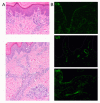Type I Interferon Signature in Chilblain-Like Lesions Associated with the COVID-19 Pandemic
- PMID: 33291622
- PMCID: PMC7768511
- DOI: 10.3390/dermatopathology7030010
Type I Interferon Signature in Chilblain-Like Lesions Associated with the COVID-19 Pandemic
Abstract
Contemporarily to the new SARS-CoV-2 mediated COVID-19 pandemic, a rise in patients with acral chilblain lesions has been described. They manifest late after mild disease or asymptomatic exposure to SARS-CoV-2. Their pathogenic evolution is currently unknown. In biopsies from three patients with acral partially ulcerating chilblain lesions that occurred associated to the COVID-19 pandemic, we analysed the expression of type I interferon induced proteins and signal transduction kinases. Histology demonstrated perivascular and periadnexal lymphohistiocytic infiltrates and endothelial dominated MxA-staining, as well as pJAK1 activation. Our findings demonstrate induction of the type I IFN pathway in lesional sections of COVID-19-associated chilblain-like lesions. This may indicate a local antiviral immune activation status associated with preceding exposure to SARS-CoV-2.
Keywords: SARS-CoV-2; chilblain; type I interferon.
Conflict of interest statement
The authors state no conflict of interest.
Figures



References
-
- Fernandez-Nieto D., Jimenez-Cauhe J., Suarez-Valle A., Moreno-Arrones O.M., Saceda-Corralo D., Arana-Raja A., Ortega-Quijano D. Characterization of acute acral skin lesions in nonhospitalized patients: A case series of 132 patients during the COVID-19 outbreak. J. Am. Acad. Dermatol. 2020;83:e61–e63. doi: 10.1016/j.jaad.2020.04.093. - DOI - PMC - PubMed
-
- Piccolo V., Neri I., Filippeschi C., Oranges T., Argenziano G., Battarra V.C., Berti S., Manunza F., Fortina A.B., Di Lernia V., et al. Chilblain-like lesions during COVID-19 epidemic: A preliminary study on 63 patients. J. Eur. Acad. Dermatol. Venereol. 2020;34:e291–e293. doi: 10.1111/jdv.16526. - DOI - PMC - PubMed
Publication types
Grants and funding
LinkOut - more resources
Full Text Sources
Miscellaneous

